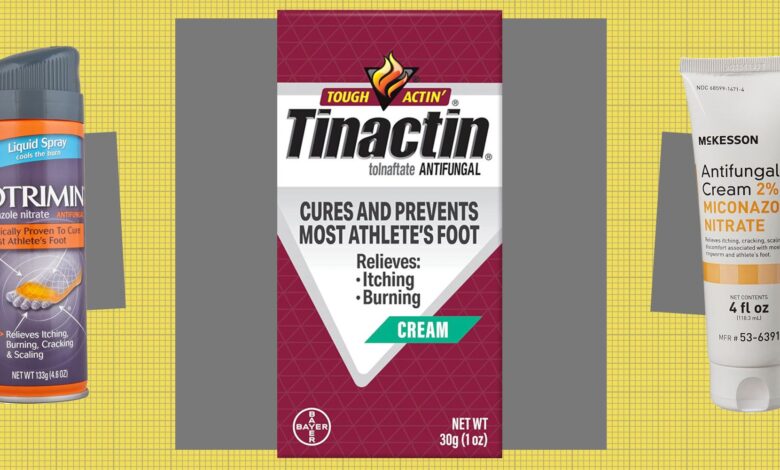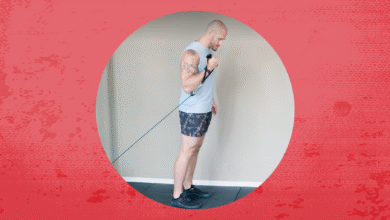The Best Anti-Fungal Creams, According to Dermatologists

Pros
- Terbinafine is generally considered the most effective over-the-counter anti-fungal ingredient
- Fast acting
- Cream is not too heavy
The active ingredient in Lamisil, terbinafine hydrochloride, is generally considered the most effective over-the-counter treatment for fungus issues, says Dr. Zeichner. And in our testing, we found that this easy-to-use, non-greasy cream really did zap our athlete’s foot problems quickly. We saw improvement after just a couple of days and it was nearly cleared up entirely in about a week. The cream has nearly no scent to speak of and the small opening of the tube made it easy to apply to our feet without getting our hands too messy (though you still need to rub it in). Compared to other anti-fungal creams we tried, this one cleared up our issues the fastest.
The tube itself is fairly small (only one ounce) but it’s okay because really, you don’t need to apply much of this stuff to get the effects. In fact, you really want to be sparing. While the cream itself doesn’t leave a greasy residue, applying too much can mean it takes a while to dry and you may find yourself rubbing it in for longer than you’d like. Also, whether you’re using this on your feet or other areas of your body, you want to make sure it’s fully dried before putting on clothes and socks to avoid unwanted moisture in the infected areas (remember, fungus loves moisture).
Read more: Best Foot Creams
| Active Ingredients | Terbinafine Hydrochloride |
|---|---|
| Format | Cream |
Pros
- Clinically proven to treat jock itch
- Great at reducing itchiness
- Easy to apply
Cons
- Must be careful to not apply too much
While all the products on this list can technically treat jock itch (as well as athlete’s foot, ringworm and other fungal rashes), we found that this one is especially good at treating jock itch. Not only does it contain the maximum amount of butenafine hydrochloride allowed for an over-the-counter cream, but the cream itself isn’t too heavy or greasy. Applying it to the affected areas was easy and foolproof. It is a cream, so it requires a bit of rubbing into the skin, but we found that it sinks in fairly quickly and didn’t leave a greasy or moist residue behind, which is especially welcome when treating jock itch, since putting clothes on top of still-wet lotion is not very fun.
Perhaps most important, however, is that it works quickly and effectively. In about the span of a week, we felt that our jock itch was almost completely gone with minimal redness, scaling and pretty much no itchiness. The directions note to apply once a day and while Dr. Zeichner advised to apply a cream twice a day, we stuck to the directions on this one. Even though we applied it once a day (at night, when we could be sure sweating in our groin area could be kept to a minimum), that stuff still worked just as well as other twice-a-day creams.
| Active Ingredients | Butenafine Hydrochloride |
|---|---|
| Format | Cream |
Pros
- Large size
- Moisturizing formula
- Relieves itch quickly
Cons
- Does not work as quickly as others on this list
Compared to other products on this list, like Lamisil and Lotrimin, this rich cream containing miconazole nitrate immediately relieved itchiness from fungal infections quickest—we’re talking almost immediately. But in the long run, those other completely cleared up fungus quicker than this one. That’s not necessarily a bad thing, even though, of course, you want to get rid of your fungal infection. Part of what makes fungal infections so annoying is that constant itch, so if you find yourself constantly scratching and being driven crazy by itching, this is a great option for you.
Also, the cream itself is richer and more moisturizing than the other formulas on this list. That doesn’t necessarily factor into the effectiveness (though, maybe it has something to do with the itch relief), but it absolutely helps to moisturize skin in addition to helping treat fungus. The base formula contains moisturizing and soothing ingredients like glycerin and aloe vera, which help to keep skin happy regardless of whether you have a rash or not. If you struggle with dry skin or just like a more moisturizing product, this is an ideal option.
| Active Ingredients | Miconazole Nitrate |
|---|---|
| Format | Cream |
Advertisement – Continue Reading Below
Pros
- Can also help prevent athlete’s foot
- Dries quickly
- Good value
Cons
- May not be strong enough for bad cases of athlete’s foot
This well-loved anti-fungal cream contains tolnaftate, which attacks not only athlete’s foot but other forms of fungal infection like ringworm and jock itch. The cream itself is smooth and easy to apply and dries quickly so it doesn’t rub off onto your socks or other clothes. It also helps soothe itching and burning on contact—though not as quickly as McKesson’s cream.
Even though this cream doesn’t get rid of athlete’s foot as quickly as Lamisil, what makes it so good for athlete’s foot is the tolnaftate in the formula. Tolnaftate helps to curb fungus development, so it not only gets rid of any fungus that’s already there, but it also helps prevent new fungus from growing. That’s especially great news if you struggle with regular cases of athlete’s foot that keeps coming back. When used regularly and as directed, it can help prevent new cases even after existing athlete’s foot has been cleared up. That said, it may not be aggressive enough to treat very extreme cases of fungal infection (if that’s the case, head to a dermatologist instead).
| Active Ingredients | Tolnaftate |
|---|---|
| Format | Cream |
Pros
- Can be applied without touching your feet
- Also deodorizes
- Comes in a multipack
Cons
- Should only be used on feet
The downfall of many anti-fungal creams is their application. With a classic cream, you have to physically rub it into the affected area—like your feet or groin—with your hands. Hopefully, you’re going to wash your hands after you apply it, but still the risk of cross-contamination is pretty high. Not to mention possible dexterity issues if you need to apply it to a hard-to-reach area. That problem is solved with this anti-fungal spray, which has the same active ingredients you find in an anti-fungal cream, but with the added convenience of spray application, so you don’t need to use your hands to rub it in.
What we loved most about this spray, as compared to the more traditional anti-fungal creams on this list, is that it not only works—and works quickly—to treat athlete’s foot, but it also deodorizes at the same time, leaving your feet smelling fresh even after a sweaty workout or long day on your feet. You really can’t argue with the convenience of a spray, especially when treating an area like your feet. A quick spray between your toes is all it takes to squash the fungus that causes athlete’s foot. Keep in mind that while you probably could use this on other areas, like your groin, it’s really designed for your feet so when in doubt, keep it to that area.
| Active Ingredients | Miconazole Nitrate |
|---|---|
| Format | Spray |

Why Use An Anti-Fungal Cream?
“If you develop an itchy, red rash between the toes or in the groin, your knee-jerk reaction should be to think that it could be caused by a fungus,” says Dr. Zeichner. Fungus grows in areas where there are lots of moisture, like your feet and groin, which are common areas for fungal infections—hence the names Athlete’s Foot and Jock Itch. “Between the toes, the skin may turn white and soft and fall apart, leading to superficial erosions,” he says. “In the groin, you may develop a red plaque with a border of scale (large, dry flakes).” Though these areas are most common, it’s also possible to develop fungal infections on other parts of your body, which is called ringworm (not actually a worm). It looks like “a red scaly patch with a ring of scale around the border,” he says. Treating these issues requires a product that’s designed to attack fungus, which is where anti-fungal creams come in.
Advertisement – Continue Reading Below

How To Use An Anti-Fungal Cream?
Apply the cream to the affected area twice daily, advises Dr. Zeichner. Typically these products work quickly, but “if a rash is not improving after twice-daily use of an antifungal cream for two weeks, you should visit your dermatologist to make sure that you get proper diagnosis and treatment,” he says.

Are Anti-Fungal Creams Safe?
“Topical use of anti-fungal creams is very safe and effective,” says Dr. Zeichner. They’re generally well tolerated by almost everyone and have been shown to have very few adverse reactions. If you do have an adverse reaction, stop using it right away and head to your dermatologist.

Meet The Experts
- Joshua Zeichner, MD, is a board-certified dermatologist in New York City. He is the associate professor and the director of cosmetic and clinical research in dermatology at Mount Sinai Hospital.
Advertisement – Continue Reading Below

Dr. Joshua Zeichner is an associate professor and the director of cosmetic and clinical research in dermatology at Mount Sinai Hospital in New York City. He is one of the country’s key opinion leaders in treating acne and rosacea and is an expert in cosmeceuticals and skincare.
As an educator, Dr. Zeichner trains residents and medical students and regularly lectures to international audiences at the major dermatology meetings. His work has been published in top peer-reviewed dermatology journals and he has consistently been voted by his peers to New York Magazine’s Best Doctors and New York City Super Doctors in the New York Times Magazine.









